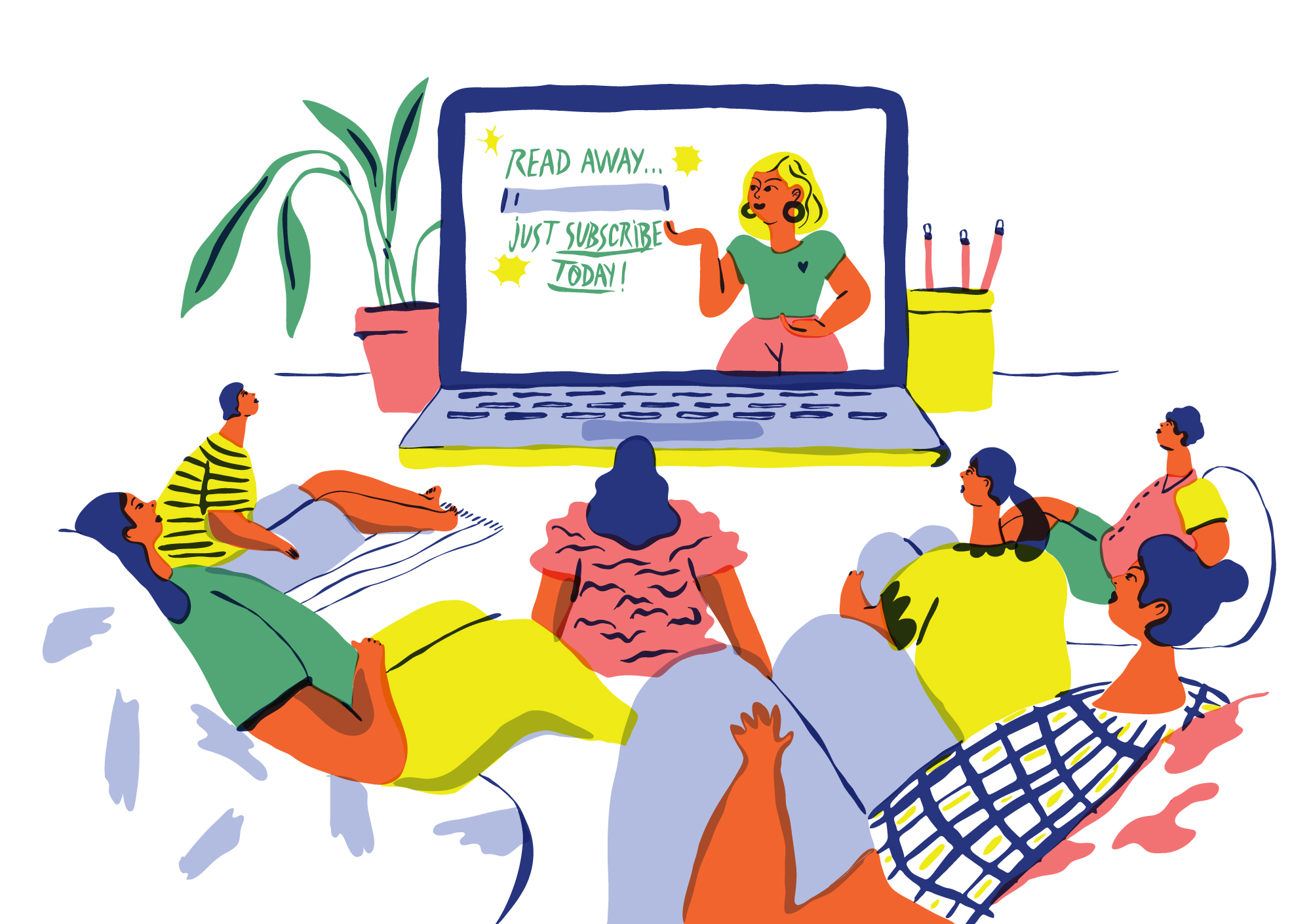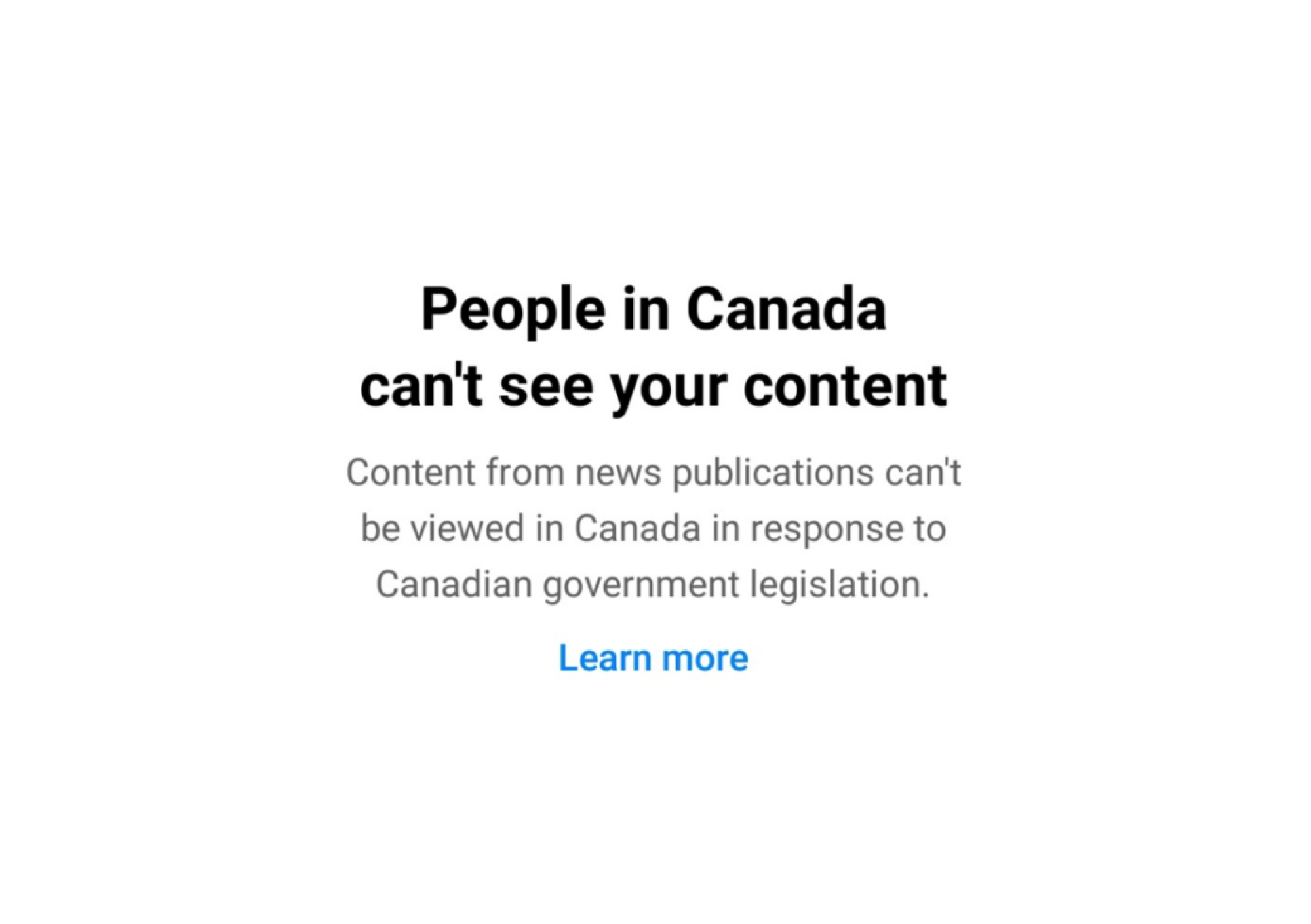I’ve subscribed to over 2,000 newsletters over the last few years. Most of them had terrible landing pages, but a few were excellent.
What sets them apart? They focus on 9 core messages. I have summarized them for you in the deep dive.
Have fun while reading.
PS: The tips don’t just apply to newsletters, but can be applied to almost all landing pages.
1. The motivation
Why should I read you? This will arouse your visitor’s interest. What do I get out of it? What goal will I achieve with it?
In the USA, a fairly simple formula has been adopted: “Get smart (about XY) in X Minutes”.
It combines three promises: fast, simple, effective!
- Morning Brew: Become smarter in just 5 minutes
- The Hustle: Get Smarter on Business and Tech
- Smart Nonsense: Get smart about nonsense 🌈
Other newsletters promise you a good start to the day:
- The Newsette: Make good mornings even better.
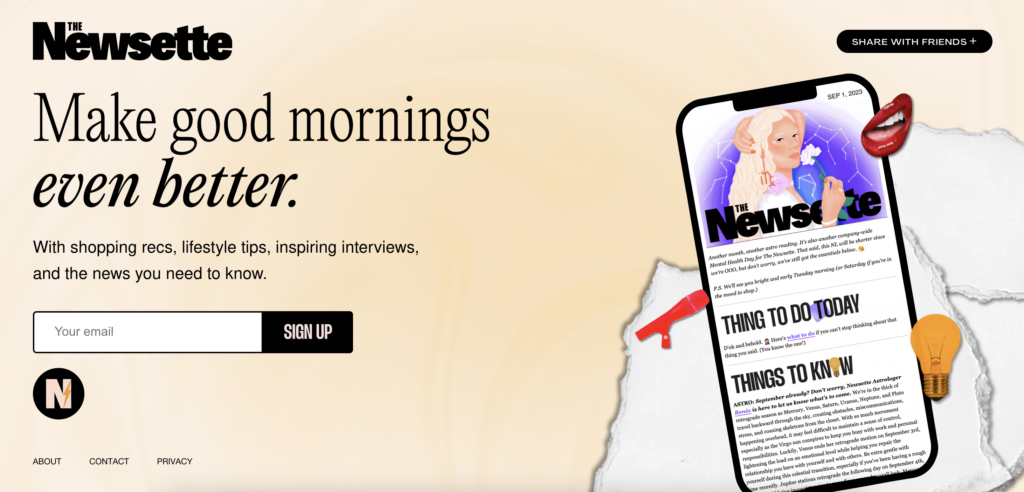
- Nice News: Wake up with a more optimistic mindset and start your day inspired.
Others help you understand the world:
- Daily Skimm: Get caught up on the top stories and information you need to start your day. We filter the noise so you don’t have to — all in a well-rounded read.
- 1440: Feed your curiosity & expand your knowledge.
- intrigue: Know what’s going on in the world, and why
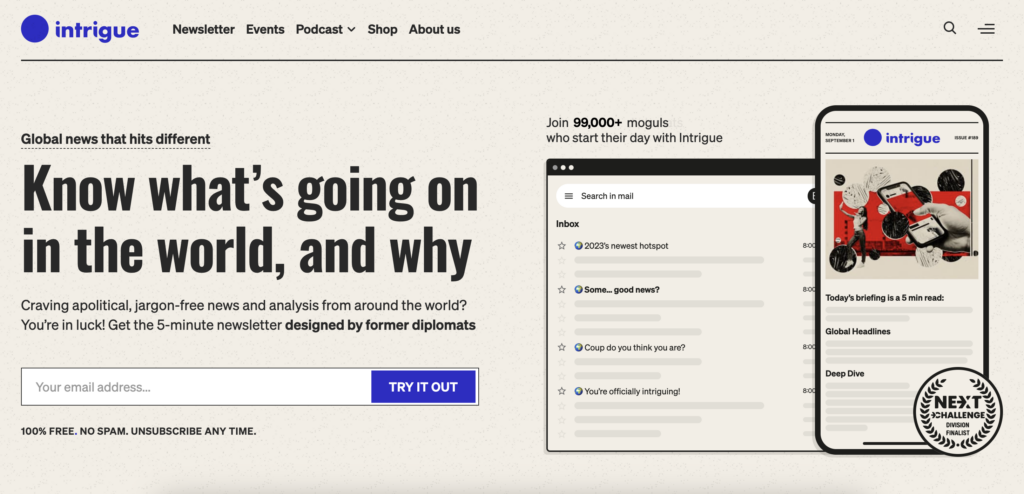
And others promise you success in your career:
- Creator Wizard: Find & Negotiate your Dream Sponsorships
- girlboss daily: Finally, an email you’ll actually look forward to. Join 250,000 ambitious women who are finding ✨ success ✨ on their own terms.
- Startup Insider Daily: Be one step ahead and actively shape your success story in the emerging startup ecosystem.
- Techpresso: Keep up with Tech in 5 minutes. Save time, become more productive and boost your career.
- SmartBrief: We make it easy for business leaders to stay up to date on their industry’s most important topics.
Personally, I like the newsletters that just make you a better person:
- Rocca News: Become the most interesting person at Happy Hour
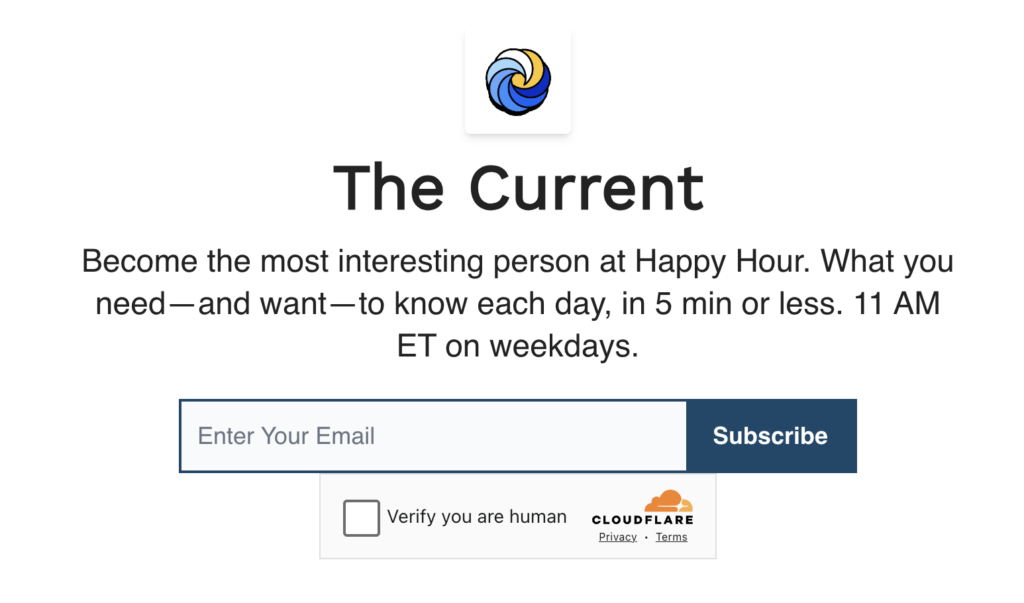
- Arnold’s Pump Club: The positive Corner of the Internet. The daily email that makes it easier to live a healthier, happier life without all the confusion and stress.
- Crooked: Put an end to doomscrolling forever
🚀 Tips:
- Here you should stimulate the imagination of your users: The motivation can either be a positive vision of their future, a problem that the newsletter solves for them, or a concrete task that it takes on for them.
- It’s best to repeat this mission statement at the top of every newsletter issue. This will remind your readers every time why your newsletter is worth it and it will be your obligation to always live up to this promise.
> To read next: How to make newsletters valuable in a reader revenue model – The Telegraph & The Edinburgh Guardian
2. The solution
Here you have to prove that you have the right content, categories and formats to fulfill this motivation. It is best to be very specific here and describe content that makes you unique and arouses desire.
🔎 Examples:
- The Newsette: With shopping recs, lifestyle tips, inspiring interviews, and the news you need to know.
- 1440: We scour 100+ sources so you don’t have to. Culture, science, sports, politics, business, and more—all in a five-minute read.
- TLDR: Get the free daily email with summaries of the most interesting stories in startups 🚀 , tech 📱 , and programming 💻!
- Startup Insider Daily: Get curated summaries of the latest startup and tech news delivered daily at 7am.
- Blazer: We source through hundreds of publications and social media accounts every day to find the best articles, photos, and inspiration from around the web. Then we package it all into a simple and brief email once a week and deliver it right to your inbox.
- The Daily Upside: Delivering razor sharp analysis and perspective on all things finance, economics, and markets.
- Semafor Flagship: The biggest stories across the globe in 100 words or less.
- chartr: Data-driven insights into business, tech, entertainment and society.
- Axios Media Trends: The trends reshaping the digital media ecosystem, by Sara Fischer.
- intrigue: Craving apolitical, jargon-free news and analysis from around the world? You’re in luck!
- Nice News: News, but only the good stuff. Nice News sends a daily digest to your inbox every morning with only positive news stories.
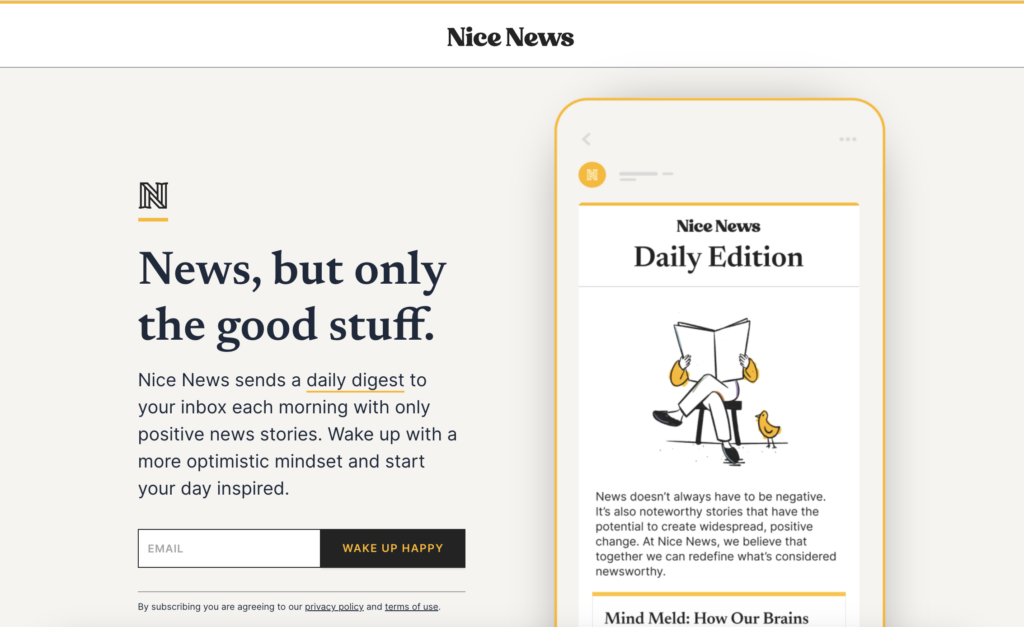
- Crooked: Get more pithy analysis of the world we live in including what’s happening, why it matters, and what you can do about it.
- Bits & Pieces (scalable Capital): Your weekly dose of financial news in 5 minutes. The most important things about markets, stocks, ETFs & Co
- Arnold’s Pump Club: Arnold’s Pump Club is a daily newsletter by Arnold Schwarzenegger. Simplify nutrition, fitness, and wellness with Arnold’s email every day.
- Smart Nonsense: Get our daily comic explaining nerdy stuff like you’re 5.
🚀 Tips:
- It is best to list the three most important points as bullet points.
- You should keep it as short as possible on the first screen, but below the fold you can explain in more detail what this content is about.
> Also by Lennart: Lock-in effects: How to make your subscription irreplaceable
3. The target group
Who is your newsletter aimed at? The more specific the target group, the faster the visitor will recognize whether the newsletter is intended for them.
🔎 Examples:
- The Hustle: innovators
- 1440: intellectually curious individuals
- Blazers: men who care about how they look
- The Peak: Canadians
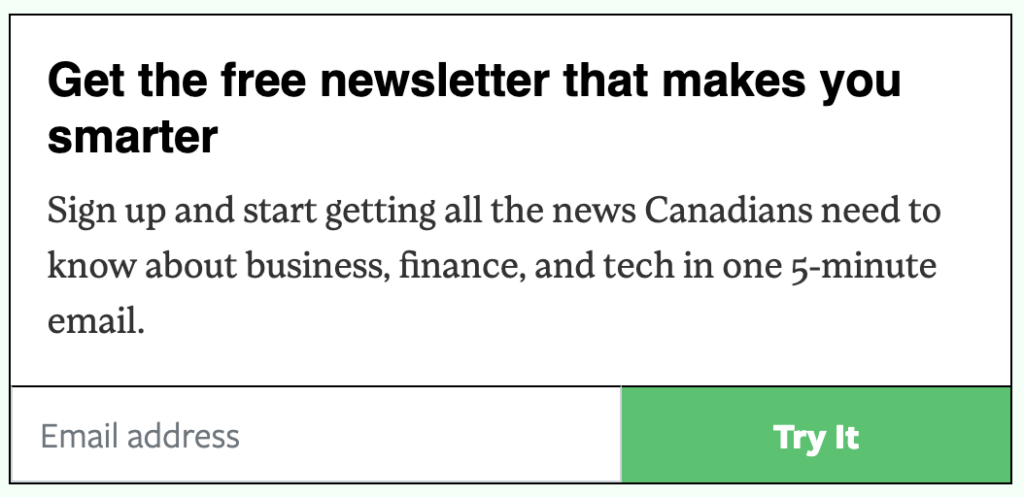
- Bits & Pieces (scalable Capital): Investors
- The Diff: industry professionals and curious generalists
- girlboss daily: ambitious women
- TLDR: busy techies
- chartr: visual thinkers and data-driven professionals
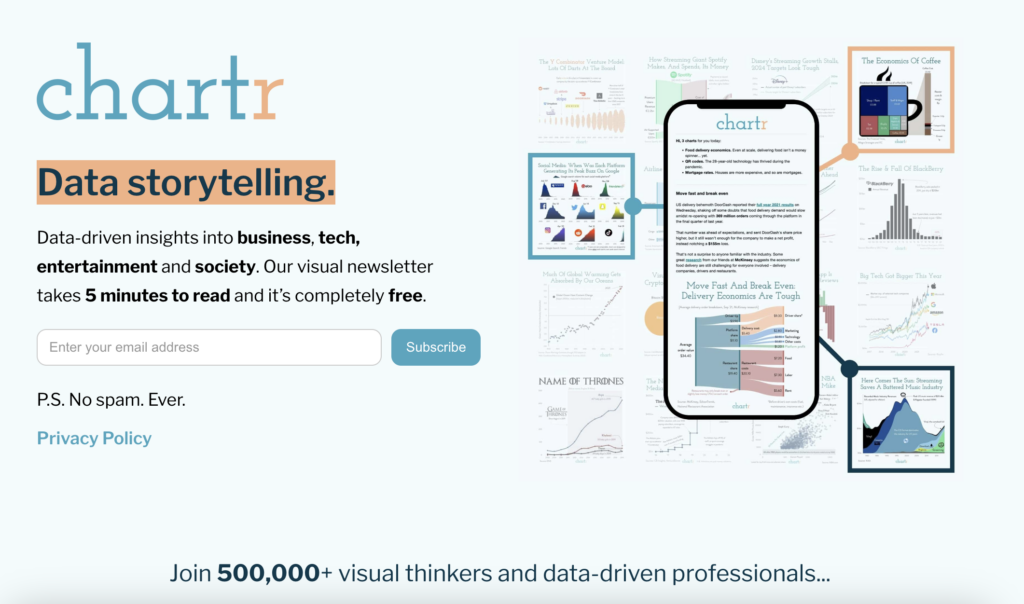
🚀 Tips:
- Always ask yourself: Is this a target group that people would like to identify with?
- You can define the target group, for example, through a common goal, socio-demographics, professional groups, etc.
- The target group is often mentioned in the value proposition or social proof and should be described in a maximum of three words.
- The best target groups also make it clear who the newsletter is not for . You don’t want to be everything for everyone, but the right solution for certain people.
4. The social proof
You can claim a lot, but is your newsletter really that great? User numbers or opinions from readers or experts build trust and make you seem relevant.
There are many possible forms, for example:
- User quotes
- Expert opinions
- Star ratings
- User numbers
- Logos of media in which you were mentioned
- Celebrities who recommend the newsletter
- Companies where your readers work
🔎 Examples:
- Techpresso: Join 100,000+ free daily readers / Read by professionals from Apple, OpenAI, Nvidia, and more
- Bits & Pieces (scalable Capital): Over 700,000 investors
- Smart Nonsense: Read by nerds from …
- The Diff: Join 50,000+ industry professionals and curious generalists
- girlboss daily: Join 250,000 ambitious women
- The Hustle: Trusted by 2.5m+ Readers
- Daily Skimm: The morning newsletter that millions wake up to
- 1440: 3,666,461 Readers today (updated every second)
- TLDR: Join 1,250,000 readers

- The Gist: Join 900,000+ readers. As seen in Forbes, goop, TechCrunch
- chartr: Join 500,000+ visual thinkers and data-driven professionals…
- intrigue: designed by former diplomats. Trusted by Professionals at Microsoft, Meta, McKinsey, …
🚀 Tips:
- The testimonials should express different aspects of your value proposition in readers’ words
- The more reputable your testimonials are in your target group, the better
5. Address concerns
Most users are initially hesitant about whether they should really enter their email address. Make them feel comfortable by openly addressing their concerns and signaling that they can trust you.
First and foremost, they have three concerns:
- Can I simply unsubscribe?
- Am I getting spam?
- Do I have to pay anything?
🔎 Examples:
- intrigue: 100% FREE. NO SPAM. UNSUBSCRIBE ANY TIME.
- TheFutureParty: It’s free!
- girlboss daily: No spam. No junk. Only the most curated content, we promise!
- chartr: completely free … PS No spam. Ever.
- The Gist: 100% free.
- 1440: 100% free, unsubscribe anytime.
🚀 Tip:
- These points should be close to the call to action, e.g. in small print above or below.
6. The frequency
The best newsletters become a regular habit that readers integrate into their daily lives. Some are read in bed in the morning, others on the way to work or home, and some on the toilet.
So when they register, show them what ritual they will develop with you.
🔎 Examples:
- Rocca News: 11 AM ET on weekdays.
- Daily Skimm: SEVEN DAYS A WEEK
- TLDR: one daily email
- Quartz Daily Brief: delivered every weekday morning
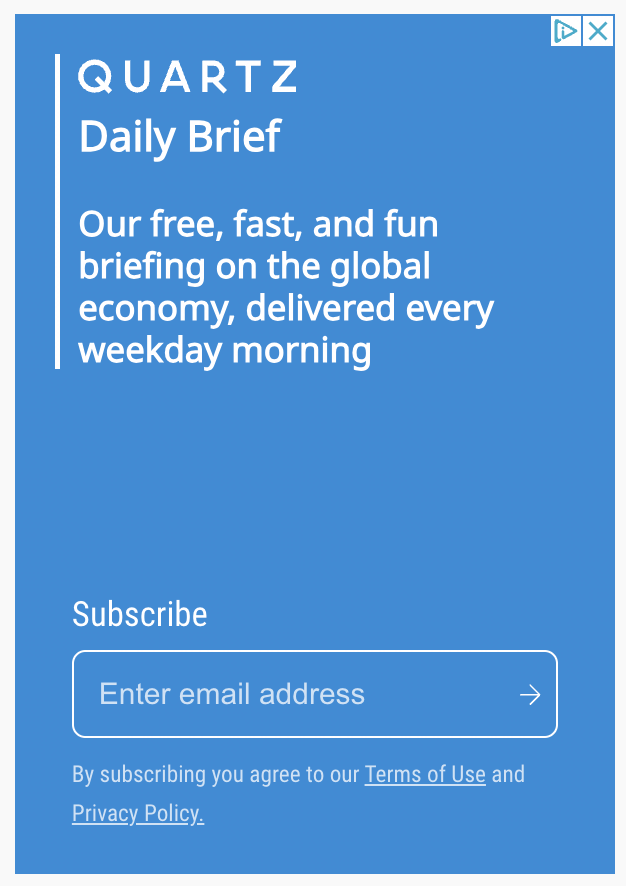
- Startup Insider Daily: daily at 7am
- The Gist: every Monday, Wednesday, Friday and Sunday morning
- Semafor Flagship: twice daily
- Axios Media Trends: Weekly – Tuesdays
- Nice News: daily digest / every morning
- Crooked: free nightly newsletter
- DTC: five times a week
- Techpresso: daily readers
- TheFutureParty: 5-min daily newsletter
- Arnold’s Pump Club: Arnold’s email every day
- girlboss daily: Monday to Friday.
🚀 Tip:
- Precise time specifications seem binding. If you promise that your email will be in their inbox every morning at 7 a.m., prospective customers will immediately see that they can rely on you.
7. The length
I admit: This newsletter is way too long again. Most readers don’t want any waffling, they’ll give you a maximum of 5 minutes of their time. So it’s no wonder that so many newsletters are optimized for exactly this reading time (or at least promise it).
🔎 Examples:
- The Hustle: 5-minute newsletter
- Rocca News: in 5 minutes or less
- The Gist: in less than 5 minutes
- chartr: takes 5 minutes to read
- The Peak: in one 5-minute email
- intrigue: 5-minute newsletter
- TheFutureParty: 5-min daily newsletter
- Morning Brew: just 5 minutes

- TLDR: in 5 minutes
- Semafor Flagship: in 100 words or less
- finish: three minutes
🚀 Tips:
- Remember that most newsletters are skimmed rather than read, so you can set aside time for a cursory reading.
- The best newsletters are respectful of their readers’ time. To underline this, Axios lists the exact word count and reading time at the beginning of each email: “Today’s AI+ is 1,214 words, a 4.5-minute read.”
- If you can’t estimate the reading time, copy your newsletter here and let us calculate it. This issue will take you 8:11 minutes.
8. The Call to Action
It’s just a small thing, but you can also tell a story on the registration button:
- “Join” suggests a community
- “Try it out” lowers the hurdle
- “Sign up for free” alleviates a worry
- and “Wake up happy” promises me a better life.
🔎 Examples:
- Axios: Sign Up
- finimize: Join Free
- Blazers: Join
- Semafor Flagship: Sign up for free
- The Peak: Try It
- intrigue: Try it out
- Nice News: Wake up happy
- Bits & Pieces (scalable capital): Get started now
- Creator Wizard: SEND ME SPONSORSHIPS ➤

🚀 Tips:
- Maximum three words.
9. The product
The same applies to newsletters: show, don’t tell! A meaningful screenshot of your newsletter says more than 1,000 words.
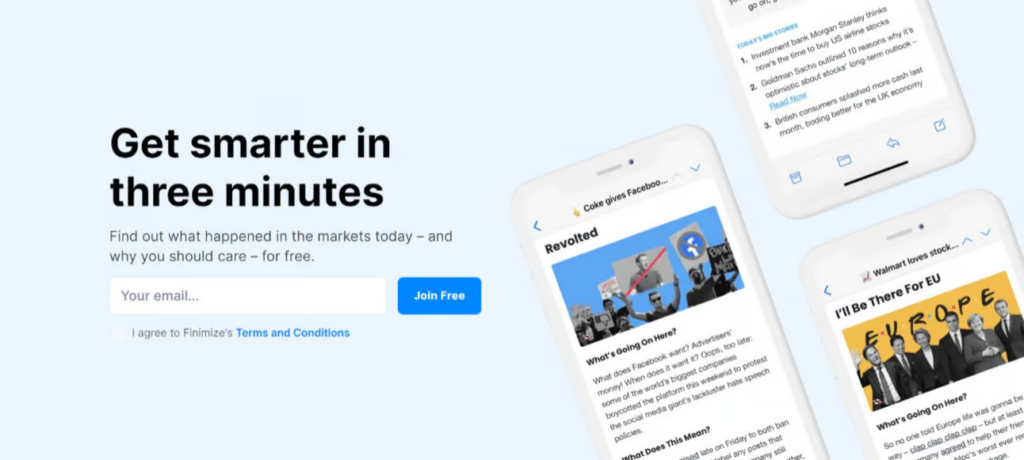
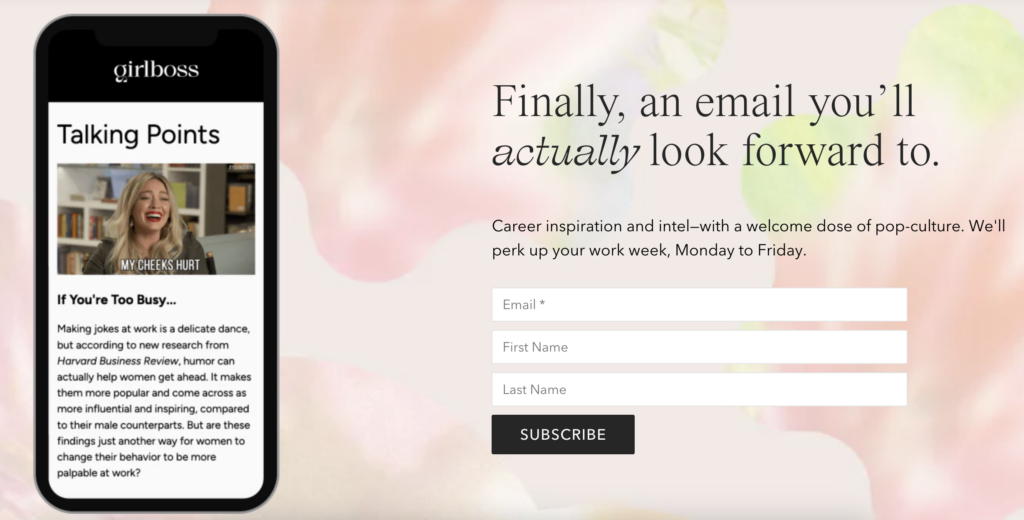
🚀 Tips:
- Some newsletters show the inbox as well as the email. This allows you to see the subject lines and the topics that await you.
- The screenshot can be animated or scrollable and thus serves directly as a reading sample.
- It doesn’t have to be a real screenshot. Feel free to shorten text or summarize sections to show more on one screen. Above all, it should give a feel for your product.
Speak German? You HAVE to sign up to Lennart’s newsletter, an essential read for anyone in the publishing industry!


